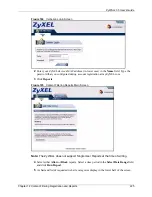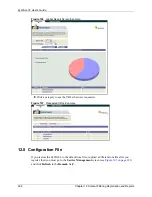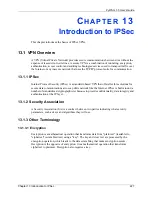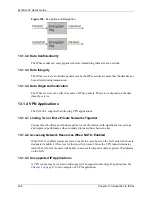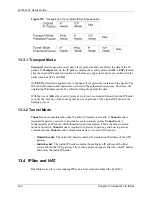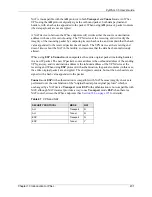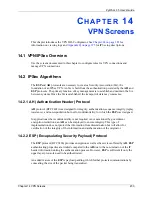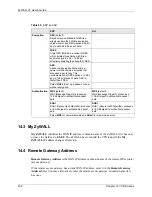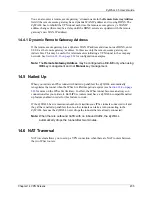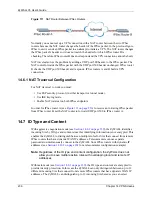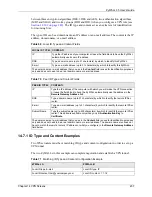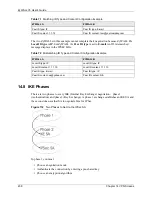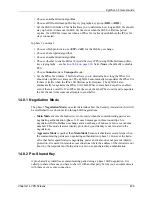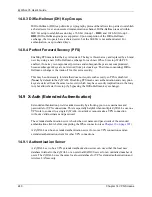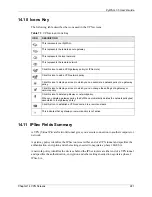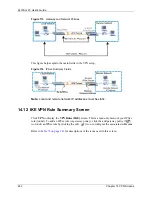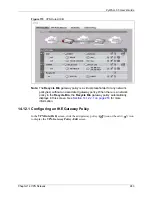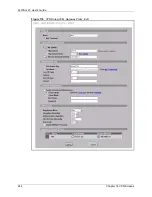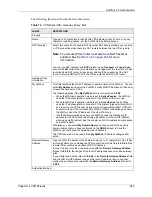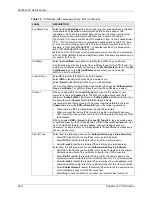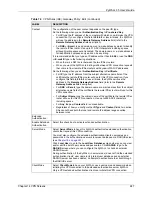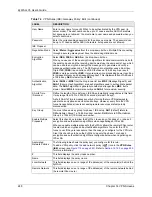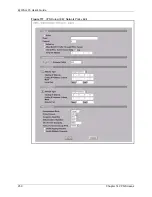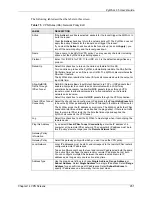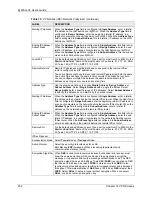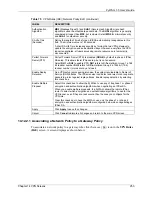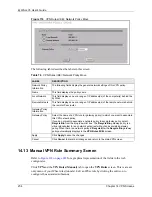
ZyWALL 35 User’s Guide
Chapter 14 VPN Screens
239
• Choose an authentication algorithm.
• Choose a Diffie-Hellman public-key cryptography key group (
DH1
or
DH2
)
.
• Set the IKE SA lifetime. This field allows you to determine how long an IKE SA should
stay up before it times out. An IKE SA times out when the IKE SA lifetime period
expires. If an IKE SA times out when an IPSec SA is already established, the IPSec SA
stays connected.
In phase 2 you must:
• Choose which protocol to use (
ESP
or
AH
) for the IKE key exchange.
• Choose an encryption algorithm.
• Choose an authentication algorithm
• Choose whether to enable Perfect Forward Secrecy (PFS) using Diffie-Hellman public-
key cryptography – see
. Select
None
(the default) to disable
PFS.
• Choose
Tunnel
mode or
Transport
mode.
• Set the IPSec SA lifetime. This field allows you to determine how long the IPSec SA
should stay up before it times out. The ZyWALL automatically renegotiates the IPSec SA
if there is traffic when the IPSec SA lifetime period expires. The ZyWALL also
automatically renegotiates the IPSec SA if both IPSec routers have keep alive enabled,
even if there is no traffic. If an IPSec SA times out, then the IPSec router must renegotiate
the SA the next time someone attempts to send traffic.
14.8.1 Negotiation Mode
The phase 1
Negotiation Mode
you select determines how the Security Association (SA) will
be established for each connection through IKE negotiations.
•
Main Mode
ensures the highest level of security when the communicating parties are
negotiating authentication (phase 1). It uses 6 messages in three round trips: SA
negotiation, Diffie-Hellman exchange and an exchange of nonces (a nonce is a random
number). This mode features identity protection (your identity is not revealed in the
negotiation).
•
Aggressive Mode
is quicker than
Main Mode
because it eliminates several steps when
the communicating parties are negotiating authentication (phase 1). However the trade-
off is that faster speed limits its negotiating power and it also does not provide identity
protection. It is useful in remote access situations where the address of the initiator is not
know by the responder and both parties want to use pre-shared key authentication.
14.8.2 Pre-Shared Key
A pre-shared key identifies a communicating party during a phase 1 IKE negotiation. It is
called pre-shared because you have to share it with another party before you can communicate
with them over a secure connection.
Summary of Contents for ZyXEL ZyWALL 35
Page 1: ...ZyWALL 35 Internet Security Appliance User s Guide Version 3 64 3 2005 ...
Page 2: ......
Page 38: ...ZyWALL 35 User s Guide 36 ...
Page 46: ...ZyWALL 35 User s Guide 44 ...
Page 74: ...ZyWALL 35 User s Guide 72 Chapter 2 Introducing the Web Configurator ...
Page 90: ...ZyWALL 35 User s Guide 88 Chapter 3 Wizard Setup ...
Page 100: ...ZyWALL 35 User s Guide 98 Chapter 4 LAN Screens ...
Page 106: ...ZyWALL 35 User s Guide 104 Chapter 5 Bridge Screens ...
Page 128: ...ZyWALL 35 User s Guide 126 Chapter 6 Wireless LAN ...
Page 135: ...ZyWALL 35 User s Guide Chapter 7 WAN Screens 133 Figure 47 General ...
Page 152: ...ZyWALL 35 User s Guide 150 Chapter 7 WAN Screens Figure 57 Dial Backup Setup ...
Page 158: ...ZyWALL 35 User s Guide 156 Chapter 7 WAN Screens ...
Page 166: ...ZyWALL 35 User s Guide 164 Chapter 8 DMZ Screens ...
Page 234: ...ZyWALL 35 User s Guide 232 Chapter 13 Introduction to IPSec ...
Page 275: ...ZyWALL 35 User s Guide Chapter 15 Certificates 273 Figure 129 My Certificate Details ...
Page 294: ...ZyWALL 35 User s Guide 292 Chapter 16 Authentication Server Figure 140 Local User Database ...
Page 314: ...ZyWALL 35 User s Guide 312 Chapter 17 Network Address Translation NAT ...
Page 318: ...ZyWALL 35 User s Guide 316 Chapter 18 Static Route ...
Page 324: ...ZyWALL 35 User s Guide 322 Chapter 19 Policy Route ...
Page 340: ...ZyWALL 35 User s Guide 338 Chapter 20 Bandwidth Management ...
Page 376: ...ZyWALL 35 User s Guide 374 Chapter 22 Remote Management ...
Page 390: ...ZyWALL 35 User s Guide 388 Chapter 24 Logs Screens Figure 198 Log Settings ...
Page 413: ...ZyWALL 35 User s Guide Chapter 25 Maintenance 411 Figure 220 Restart Screen ...
Page 414: ...ZyWALL 35 User s Guide 412 Chapter 25 Maintenance ...
Page 440: ...ZyWALL 35 User s Guide 438 Chapter 28 WAN and Dial Backup Setup ...
Page 456: ...ZyWALL 35 User s Guide 454 Chapter 31 DMZ Setup ...
Page 460: ...ZyWALL 35 User s Guide 458 Chapter 32 Route Setup ...
Page 470: ...ZyWALL 35 User s Guide 468 Chapter 33 Remote Node Setup ...
Page 522: ...ZyWALL 35 User s Guide 520 Chapter 39 System Information Diagnosis ...
Page 538: ...ZyWALL 35 User s Guide 536 Chapter 40 Firmware and Configuration File Maintenance ...
Page 550: ...ZyWALL 35 User s Guide 548 Chapter 42 Remote Management ...
Page 558: ...ZyWALL 35 User s Guide 556 Chapter 43 IP Policy Routing ...
Page 574: ...ZyWALL 35 User s Guide 572 Chapter 45 Troubleshooting Figure 364 Java Sun ...
Page 602: ...ZyWALL 35 User s Guide 600 Appendix C IP Subnetting ...
Page 608: ...ZyWALL 35 User s Guide 606 Appendix E PPTP ...
Page 626: ...ZyWALL 35 User s Guide 624 Appendix G Triangle Route ...
Page 656: ...ZyWALL 35 User s Guide 654 Appendix J Importing Certificates ...
Page 658: ...ZyWALL 35 User s Guide 656 Appendix K Command Interpreter ...
Page 664: ...ZyWALL 35 User s Guide 662 Appendix L Firewall Commands ...
Page 668: ...ZyWALL 35 User s Guide 666 Appendix M NetBIOS Filter Commands ...
Page 674: ...ZyWALL 35 User s Guide 672 Appendix O Brute Force Password Guessing Protection ...
Page 696: ...ZyWALL 35 User s Guide 694 Appendix Q Log Descriptions ...

